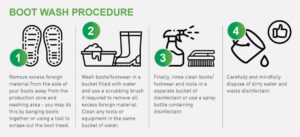Read the latest information on
Foot-and-mouth disease
Pests, weeds and diseases can be carried on anything that moves, including humans. Dirty boots can be one way that unwanted weeds and diseases may be carried onto your property.
Having a footbath on-farm provides your property and the broader agriculture industry with an added layer of protection against the devastation of disease outbreak.
Asking visitors to clean and disinfect their boots as they arrive to your property, particularly if they are going into your production zones, can help minimise the risk of an incursion.
Foot baths are designed to sanitise footwear of farm visitors using a three per cent citric acid solution.
How to make and maintain a footbath on-farm

Set up each footbath station on a flat surface.
Scrubbing brushes and scraping tools should be provided to guests to assist with cleaning.
After the footbaths have been used, dispose of the water and decontaminant away from production areas and water sources. Take note of label instructions for disposal of the decontaminant.
There are three simple rules when allowing visitors and workers to wear their own footwear in your production areas:
Cleaning step
Before washing, use a strong bristled brush to remove all visible debris. Boots should be free of dirt, mud, manure, and plant material before using the footbath. These kinds of organic matter quickly contaminate the water and prevent the disinfectant from killing germs, so the boots need to be generally clean before you wash and disinfect.
Washing step
The footbath should be a container which allows easy access. Ensure the container can fit a large boot so that the liquid saturates all parts of the footwear. Adding some soap or detergent to the water can clean better than using water alone. If shoes were very dirty to begin with, use the scrubbing brush while standing in the soap solution to thoroughly clean the soles of the shoe.
Disinfection step
For maximum cleaning a disinfection step should follow the washing step.
A second footbath should contain disinfecting products. These must be refreshed regularly as build-up of dirt and rainwater in these solutions will lessen their effectiveness.
You can use bleach diluted to one per cent active sodium hypochlorite (the active ingredient in bleach). For example, dilute a bleach solution which is four per cent active sodium hypochlorite using three parts water to one part bleach.
Any other farm disinfectants can also be used as per their label instructions.
As leather or fabric shoes can be damaged by prolonged exposure to disinfectants, a final rinse with fresh water is advised for them.
Learn more about setting up a footbath.